The Mediatic treatment of a female head of state
DOI:
https://doi.org/10.11606/extraprensa2019.153707Keywords:
journalism, magazine, speech analysis, president, sexismAbstract
This article is part of the analysis of the discursive pecheutian analysis with journalism. It seeks to discursively analyze the mediatic treatment of a female head of state, in order to investigate the possible meanings present in the analysis corpora, which are part of Istoé and Época's articles for President Dilma Rousseff, published on April 1, 2016 and August 20, 2015, respectively. Thus, we have as a cut of analysis the discursive marks of the feminine in power, the conditions of production and the historicity of each magazine, as well as the senses of women not belonging to politics. We understand that both materials use discursive memory to produce an erasure and silencing of meanings. This memory propitiates reports about men in positions in the executive and women as their wives, making their readers perceive, thus, senses limited to the woman in the power. In general, in the shadow of man and not as protagonist.
Downloads
References
COURTINE, Jean Jacques. Análise do discurso político: o discurso comunista endereçado aos cristãos. São Carlos: EdUFSCar, 2009.
INTER PARLIAMENTARY UNION. Women in national parliaments.
Endereço eletrônico: <http://archive.ipu.org/wmn-e/classif.Htm>. jun. 2018.
MARIANI, Bethania. O PCB e a imprensa: os comunistas no imaginário dos jornais (1922-1989). Rio de Janeiro: Revan; Campinas: UNICAMP, 1998.
MEMORIAL DESCRITIVO REVISTA ISTOÉ. Centro universitário Belas Artes de São Paulo. Endereço eletrônico:
<https://pt.scribd.com/doc/22806012/Memorial-Descritivo-Revista-Istoe>. São Paulo, 2009. Data de acesso: dez. 2017.
MIGUEL, Luis Felipe; BIROLI, Flávia. Feminismo e Política. São Paulo: Boitempo, 2016.
MORENO, Rachel. A imagem da mulher na mídia: controle social comparado. São Paulo: Publischer, 2012.
ORLANDI, Eni; RODRIGUES, Suzy Lagazzy. Discurso e Textualidade. 3. ed. Campinas: Pontes, 2015.
ORLANDI, Eni P. Análise de discurso: princípios e procedimentos. Campinas, SP: Pontes, 1999.
___. Segmentar ou recortar? IN: Linguística: questões e controvérsias. Uberaba, MG: Faculdades Integradas de Uberaba, 1984.
PARDELLAS, Sérgio; BERGAMASCO, Débora. Uma presidente fora de si, Revista IstoÉ, 1 de abril de 2016.
SANCHES, Romário Duarte; SOUSA, Rayniere Felipe Alvarenga de. Análise social e discursiva nas capas da revista época. Departamento de Letras | Universidade Federal do Maranhão, Maranhão, v. 6, n. 10, 2015. Disponível em:
<http://www.periodicoseletronicos.ufma.br/index.php/littera/article/view/3558/1594>. Acesso em: jul. 2017.
SANTOS NETO, Helena Iracy Cerquiz. Análise do Discurso Radiofônico: O Acontecimento Apagão em Florianópolis. 2015. 290 f. Tese (Doutorado) – Programa de Pós-Graduação em Ciências da Linguagem, Universidade do Sul de Santa Catarina, Palhoça, 2015.
SÃO PAULO, Centro Universitário Belas Artes. Memorial Descritivo Revista IstoÉ. -, São Paulo, nov.2009.Disponível em: <https://pt.scribd.com/doc/22806012/Memorial-Descritivo-Revista-Istoe>. Acesso em: mai. 2017.
VIEIRA, João Luiz. Dilma, se eu fosse seu amigo lhe diria: erotize-se. Revista Época, dia 20 de agosto de 2015.
Downloads
Published
Issue
Section
License
Ao submeter qualquer material científico para Extraprensa, o autor, doravante criador, aceita licenciar seu trabalho dentro das atribuições do Creative Commons, na qual seu trabalho pode ser acessado e citado por outro autor em um eventual trabalho, porém obriga a manutenção de todos os autores que compõem a obra integral, inclusive aqueles que serviram de base para o primeiro.
Toda obra aqui publicada encontra-se titulada sob as seguintes categorias da Licença Creative Commons (by/nc/nd):
- Atribuição (de todos os autores que compõem a obra);
- Uso não comercial em quaisquer hipóteses;
- Proibição de obras derivadas (o trabalho não poderá ser reescrito por terceiros. Apenas textos originais são considerados);
- Distribuição, exibição e cópia ilimitada por qualquer meio, desde que nenhum custo financeiro seja repassado.
Em nenhuma ocasião a licença de Extraprensa poderá ser revertida para outro padrão, exceto uma nova atualização do sistema Creative Commons (a partir da versão 3.0). Em caso de não concordar com esta política de Direito Autoral, o autor não poderá publicar neste espaço o seu trabalho, sob pena de o mesmo ser removido do conteúdo de Extraprensa.







